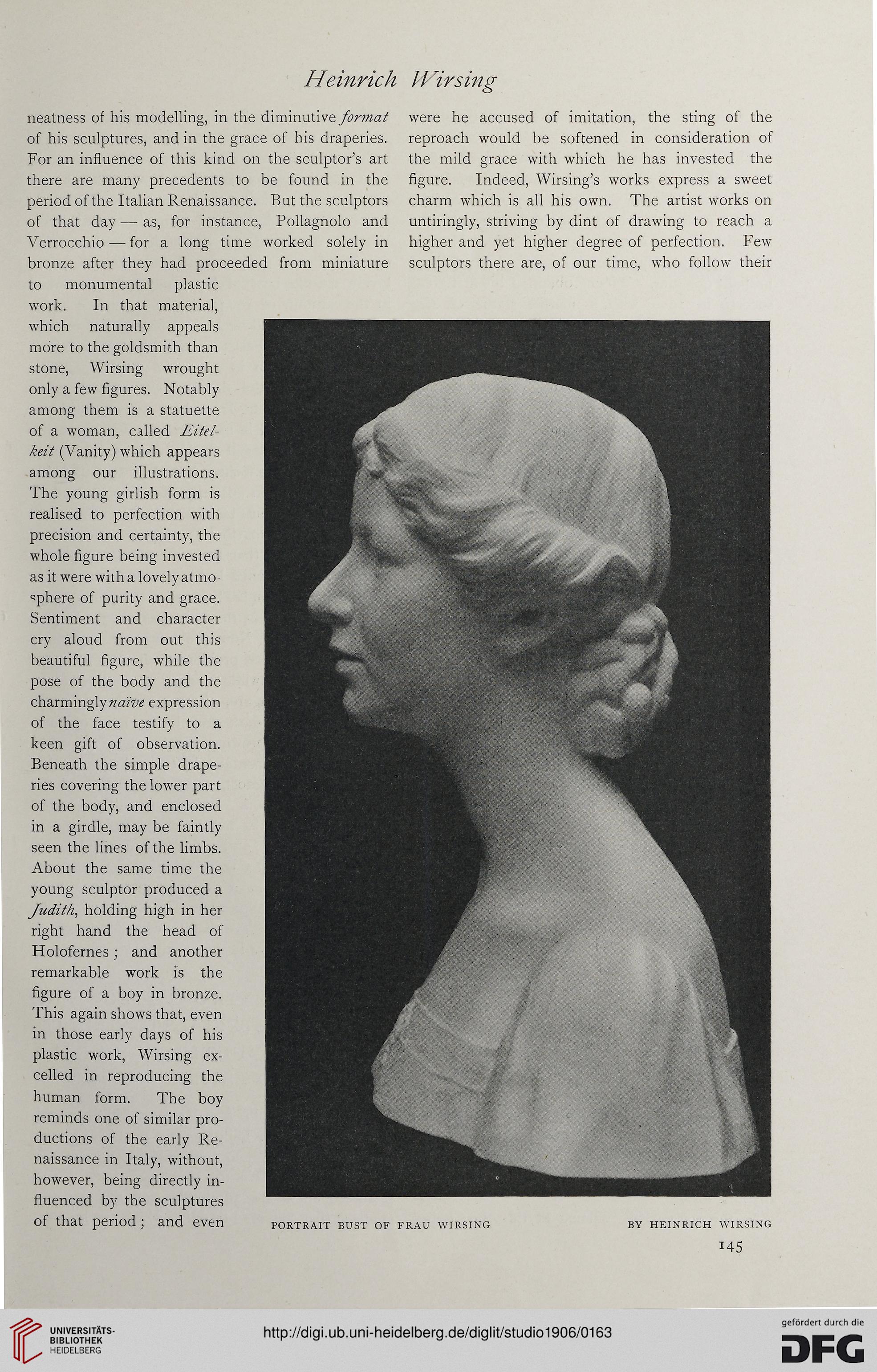Heinrich IVirsing
neatness of his modelling, in the diminutive format
of his sculptures, and in the grace of his draperies.
For an influence of this kind on the sculptor’s art
there are many precedents to be found in the
period of the Italian Renaissance. But the sculptors
of that day — as, for instance, Pollagnolo and
Verrocchio — for a long time worked solely in
bronze after they had proceeded from miniature
to monumental plastic
work. In that material,
which naturally appeals
more to the goldsmith than
stone, Wirsing wrought
only a few figures. Notably
among them is a statuette
of a woman, called Eitcl-
keit (Vanity) which appears
among our illustrations.
The young girlish form is
realised to perfection with
precision and certainty, the
whole figure being invested
as it were with a lovely atmo-
sphere of purity and grace.
Sentiment and character
cry aloud from out this
beautiful figure, while the
pose of the body and the
charmingly naive expression
of the face testify to a
keen gift of observation.
Beneath the simple drape-
ries covering the lower part
of the body, and enclosed
in a girdle, may be faintly
seen the lines of the limbs.
About the same time the
young sculptor produced a
Judith, holding high in her
right hand the head of
Holofernes; and another
remarkable work is the
figure of a boy in bronze.
This again shows that, even
in those early days of his
plastic work, Wirsing ex-
celled in reproducing the
human form. The boy
reminds one of similar pro-
ductions of the early Re-
naissance in Italy, without,
however, being directly in-
fluenced by the sculptures
of that period; and even
were he accused of imitation, the sting of the
reproach would be softened in consideration of
the mild grace with which he has invested the
figure. Indeed, Wirsing’s works express a sweet
charm which is all his own. The artist works on
untiringly, striving by dint of drawing to reach a
higher and yet higher degree of perfection. Few
sculptors there are, of our time, who follow their
BY HEINRICH WIRSING
PORTRAIT BUST OF FRAU WIRSING
I45
neatness of his modelling, in the diminutive format
of his sculptures, and in the grace of his draperies.
For an influence of this kind on the sculptor’s art
there are many precedents to be found in the
period of the Italian Renaissance. But the sculptors
of that day — as, for instance, Pollagnolo and
Verrocchio — for a long time worked solely in
bronze after they had proceeded from miniature
to monumental plastic
work. In that material,
which naturally appeals
more to the goldsmith than
stone, Wirsing wrought
only a few figures. Notably
among them is a statuette
of a woman, called Eitcl-
keit (Vanity) which appears
among our illustrations.
The young girlish form is
realised to perfection with
precision and certainty, the
whole figure being invested
as it were with a lovely atmo-
sphere of purity and grace.
Sentiment and character
cry aloud from out this
beautiful figure, while the
pose of the body and the
charmingly naive expression
of the face testify to a
keen gift of observation.
Beneath the simple drape-
ries covering the lower part
of the body, and enclosed
in a girdle, may be faintly
seen the lines of the limbs.
About the same time the
young sculptor produced a
Judith, holding high in her
right hand the head of
Holofernes; and another
remarkable work is the
figure of a boy in bronze.
This again shows that, even
in those early days of his
plastic work, Wirsing ex-
celled in reproducing the
human form. The boy
reminds one of similar pro-
ductions of the early Re-
naissance in Italy, without,
however, being directly in-
fluenced by the sculptures
of that period; and even
were he accused of imitation, the sting of the
reproach would be softened in consideration of
the mild grace with which he has invested the
figure. Indeed, Wirsing’s works express a sweet
charm which is all his own. The artist works on
untiringly, striving by dint of drawing to reach a
higher and yet higher degree of perfection. Few
sculptors there are, of our time, who follow their
BY HEINRICH WIRSING
PORTRAIT BUST OF FRAU WIRSING
I45





